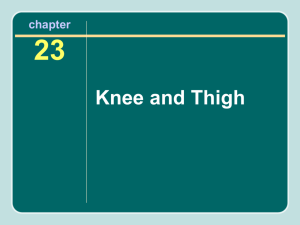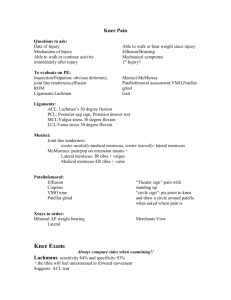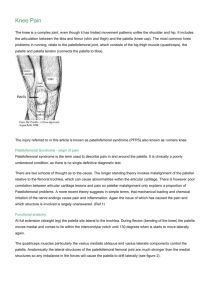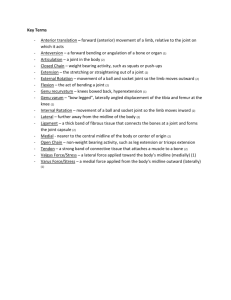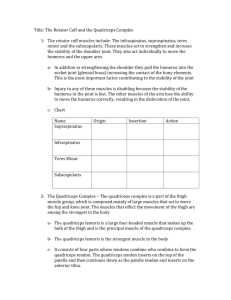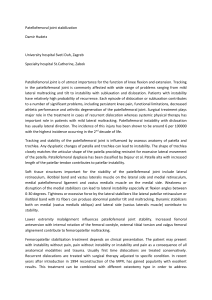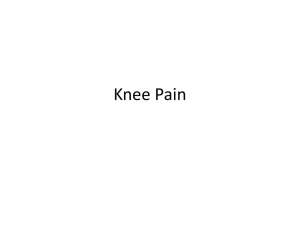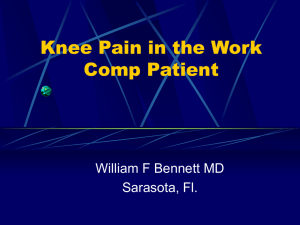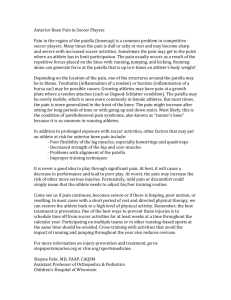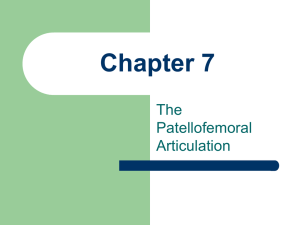Knee Joint Region Case Presentation – Part 1
advertisement
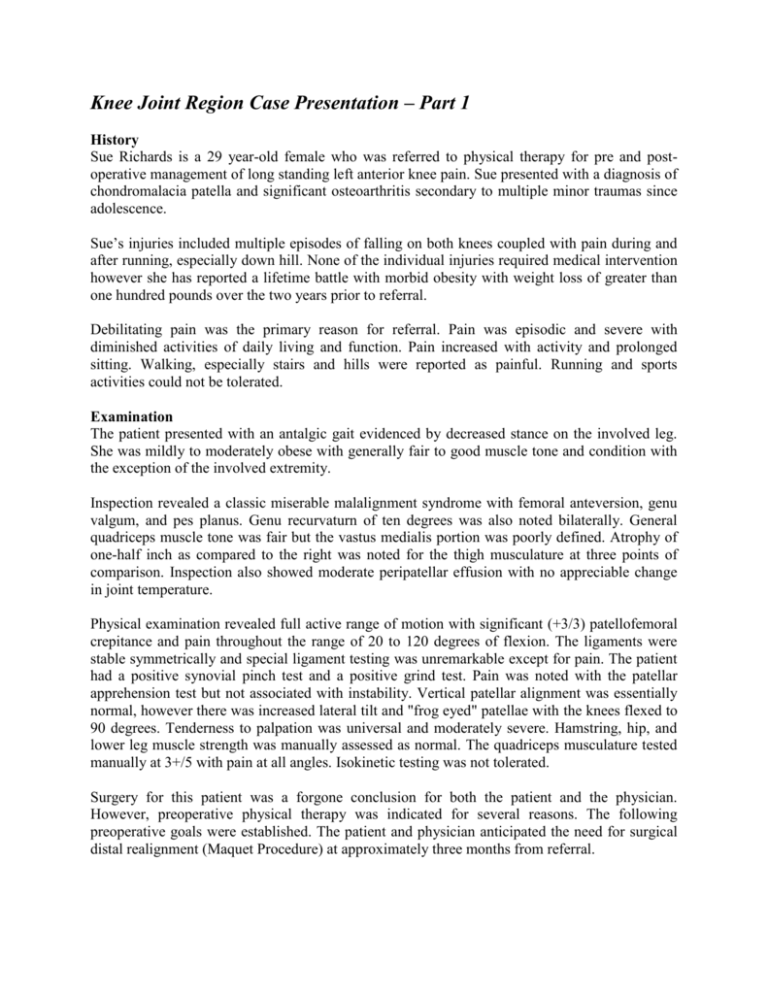
Knee Joint Region Case Presentation – Part 1 History Sue Richards is a 29 year-old female who was referred to physical therapy for pre and postoperative management of long standing left anterior knee pain. Sue presented with a diagnosis of chondromalacia patella and significant osteoarthritis secondary to multiple minor traumas since adolescence. Sue’s injuries included multiple episodes of falling on both knees coupled with pain during and after running, especially down hill. None of the individual injuries required medical intervention however she has reported a lifetime battle with morbid obesity with weight loss of greater than one hundred pounds over the two years prior to referral. Debilitating pain was the primary reason for referral. Pain was episodic and severe with diminished activities of daily living and function. Pain increased with activity and prolonged sitting. Walking, especially stairs and hills were reported as painful. Running and sports activities could not be tolerated. Examination The patient presented with an antalgic gait evidenced by decreased stance on the involved leg. She was mildly to moderately obese with generally fair to good muscle tone and condition with the exception of the involved extremity. Inspection revealed a classic miserable malalignment syndrome with femoral anteversion, genu valgum, and pes planus. Genu recurvaturn of ten degrees was also noted bilaterally. General quadriceps muscle tone was fair but the vastus medialis portion was poorly defined. Atrophy of one-half inch as compared to the right was noted for the thigh musculature at three points of comparison. Inspection also showed moderate peripatellar effusion with no appreciable change in joint temperature. Physical examination revealed full active range of motion with significant (+3/3) patellofemoral crepitance and pain throughout the range of 20 to 120 degrees of flexion. The ligaments were stable symmetrically and special ligament testing was unremarkable except for pain. The patient had a positive synovial pinch test and a positive grind test. Pain was noted with the patellar apprehension test but not associated with instability. Vertical patellar alignment was essentially normal, however there was increased lateral tilt and "frog eyed" patellae with the knees flexed to 90 degrees. Tenderness to palpation was universal and moderately severe. Hamstring, hip, and lower leg muscle strength was manually assessed as normal. The quadriceps musculature tested manually at 3+/5 with pain at all angles. Isokinetic testing was not tolerated. Surgery for this patient was a forgone conclusion for both the patient and the physician. However, preoperative physical therapy was indicated for several reasons. The following preoperative goals were established. The patient and physician anticipated the need for surgical distal realignment (Maquet Procedure) at approximately three months from referral. Plan First, control pain and inflammation. The active joint inflammatory response as indicated by pain and effusion would potentially complicate surgery. As with most conditions, the pain control must be achieved for the patient to progress to other forms of therapy, especially exercise. Second, preserve range of motion and strength. Because of the acute pain present, it was feared the patient would progressively lose flexibility and strength due to disuse. Third, improve strength as tolerated. This patient suffered significantly diminished quadriceps strength whether physiologic or secondary to pain. In general, it is desirable to be as strong as possible prior to surgery because of the natural consequence of weakness post-operatively. Learning Objectives for Anterior Knee Pain Case Study - Part 1 At the end of this case presentation the student should be able to: 1. Review anatomy and the kinesiology of the knee joint; 2. Describe the normal biomechanics of the patellofemoral joint and describe the most common variations from normal" (e.g. lateral tracking, patella baja, patella alta, etc); 3. Identify which muscles may be weak due to patellofemoral dysfunction and describe any muscles that may be too tight; how would you identify these weaknesses/tightnesses? 4. Define chrondromalacia patella, identify the more up to date term for this condition; 5. Rationalize how the reported multiple trauma events may have contributed to chondromalacia and osteoarthritis; 6. Define morbid obesity and evaluate how this has contributed to this patient’s symptoms and problems; 7. Postulate how this chronic problem developed and how it may be related to long term exercise; 8. Define the following terms: (a) antalgic gait, (b) femoral anteversion, (c) genu valgum, (d) genu recurvatum, (e) peripatellar effusion (f) pes planus. 9. How do these characteristics affect the normal biomechanics of the joints involved? 10. Discuss the Maquet Procedure and the potential problems associated with it. 11. What may have caused the atrophy of the right thigh? clinically? 12. What do the ‘synovial pinch test’ and ‘grind test’ actually test and how reliable are they? 13. Outline the physical therapy treatment program that you will place this patient on preoperatively and post-operatively. 14. What ICD code describes this patient? How is atrophy measured
